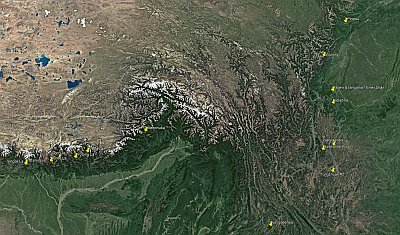|
Plants small to shrub-like, spreading widely and forming extensive stands; rhizomes leptomorph. Culms 1–3 m, 0.2–1 cm in diam., tillering to give pluricaespitose clumps; nodes level; internodes terete, smooth, not grooved, initially purple-spotted, becoming more uniformly purple after exposure, with light deciduous wax at first. Branches initially 1-3, very erect, appressed, developing promptly within culm sheath, basal internodes often long, secondary branches arching out, often distant from culm, all branches subtended by a sheath, prolonged terminal growth; buds initially open at front, prophyll 2-keeled. Culm sheaths persistent; blade small, lanceolate. Leaf sheaths persistent; blade thin, venation tessellate. Synflorescence racemose or sparsely paniculate, ebracteate, branches few and erect. Spikelets pedicellate, pedicels glabrous; stamens 3; style branches 3. Name from Saron (Greek, a broom or sweepings), and Calamus (Greek, a reed), as the culms with erect branches are used as brooms in Bhutan, and the genus includes the last few Asian species of Arundinaria that needed to be swept into a new genus.
Sarocalamus is a small genus of approximately 4-6 species, native to the E Himalayas and SW China. They are morphologically closest to Arundinaria, a genus now restricted to species native to N America, and among the Asian genera considered rather similar to Bashania. Distinguished from Bashania by the lack of compressed basal branch internodes, leading to fewer branches at the base of the complement, and the smaller, thinner leaves, and distinguished from Arundinaria by the narrower spikelets and glabrous pedicels. Note that Gelidocalamus is a very different genus, not closely related to Sarocalamus or Bashania. Rather than having few major branches with many branchlets and many leaves, it has many branches with few branchlets and few leaves.
The erect racemose synflorescences with few branches and spikelets have been noticed by several botanists while describing new species, without an appreciation that they signalled a generic distinction. Hence the species names Arundinaria racemosa, Arundinaria pauciflora, Sinarundinaria par[v]iflora, and Bashania spanostachya, all derived from the same character.
Although morphologically similar to Arundinaria in branching, leptomorph rhizome form and inflorescence structure, and to Bashania in rhizome form and inflorescence structure, DNA analysis shows that Sarocalamus is not closely related to either, as reflected in the thinner leaf blades with prolonged terminal growth of branchlets. The smooth, wax-free, purple-spotted culm internodes are very similar to those seen in Fargesia species.
Growing in tourist areas in China and the Himalayas, and likely to be and to have been introduced to the west on different occasions, but separating these from similar but unrelated bamboos is rather difficult because of misidentifications and misapplication of names.
Distribution
Species type localities and other selected collection locations (click to enlarge):

Stapleton, C. M. A., Ní Chonghaile, G. & Hodkinson, T. R. (2004). Sarocalamus, a new Sino-Himalayan bamboo genus (Poaceae–Bambusoideae). Novon 14: 345–349 Online at BHL, PDF
Stapleton, C. M. A. (2019). New combinations in Sarocalamus for Chinese bamboos. Nord. J. Bot. 37(7): 1-6. PDF
|

